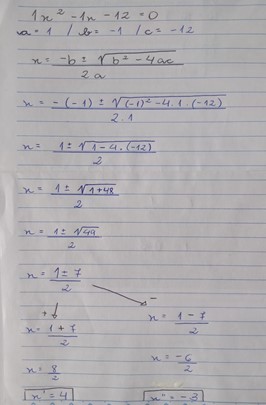Equação de segundo grau completa
- Comentários desativados em Equação de segundo grau completa
A equação de segundo grau tem esse nome pois nela, há uma incógnita elevada ao quadrado. Ela é representada dessa forma:
ax2 + bx + c = 0
O x é sempre a incógnita, ou seja, o que nós queremos descobrir, e as letras a, b e c são os coeficiantes, ou seja, os valores que nós já sabemos.
Informações importantes: para ser de segundo grau, o a deve ser diferente de 0, mas o b e o c podem ser 0. Nesses casos, ela se torna incompleta (hoje vamos trabalhar somente com as completas); e sempre haverá dois resultados, ou seja, dois valores para x.
Um exemplo de equação de segundo grau completa:
5x2 + 2x + 2 = 0
Para resolver essas equações nós temos uma fórmula (que funciona também para as incompletas), que é a famosa Fórmula de Bhaskara. Sendo ela:

Ela também pode ser escrita com “delta” dentro do radical, onde, separadamente, é calculado seu valor, usando a fórmula. Aqui está escrito de forma mais fácil, pois o cálculo do “delta” é realizado junto, em uma só fórmula.
Usando a fórmula fica muito simples, é só substituir os valores e calcular. Vamos dar um exemplo com a equação usada antes.

S={-3, 4}
Complete second-degree equation
The second-degree equation has this name because in it, there is an unknown raised to 2. It is represented in this way:
ax2 + bx + c = 0
The x is always the unknown, so it is what we want to discover, and the letters a, b and c are the coefficients, the values that we already know.
Important information: to be a second degree, the a must be different from 0, but b and c can be 0. In this cases it becomes an incomplete equation (today we will only work with complete ones); and there will always be two results, that is, two values to the x.
An example of second-degree complete equation:
1x2 – 1x – 12 = 0
To solve this equation, we have a formula (which also works for incomplete ones), that is the famous Bhaskara Formula.

It can also be written with “delta” inside the radical, where, separately, its value is calculated using the formula. Here it is written in an easier way, since the calculation of the “delta” is performed together, in a single formula
Using the formula is quite simple, just replace the values and calculate. Let us take an example with the equation used before.

S={-3, 4}
